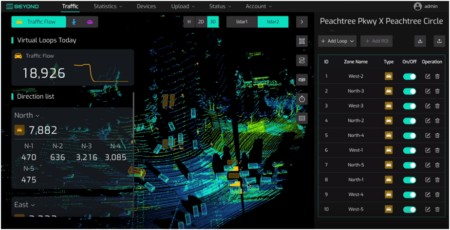The German city of Düsseldorf has officially opened a cutting-edge connected and automated vehicle (CAV) testing facility comprising a 12.4 mile-long (20km) route on public roads that are dedicated and equipped to trial vehicle-to-everything (V2X) technologies.
Part funded by the German Federal Ministry of Transport and Digital Infrastructure (BMVI) under its ‘Automation and Networking in Road Traffic’ program, the US$17.4m (€14.8m) project is known as KoMoD (Cooperative Mobility in the Digital Test Field Düsseldorf).
The testbed is unique in Germany as it covers both highways and inner-city urban roads, including sections of the A57 and A52 motorways, the Heerdter Dreieck, the Rheinallee Tunnel, the Rheinkniebrücke Bridge, the city’s Friedrichstadt district, and the Vodafone parking garage, which will be used to trial the communication of real-time occupancy information and fully automated parking systems.
At the launch event, a fleet of eight test vehicles, including a Rheinbahn bus, were presented, as well as seven bicycles fitted with the ‘Grüner Welle’ (Green Wave) traffic signal phase indicating application. In 2019, the testbed with its full communications infrastructure will be opened up to third parties for CAV research projects.
As one of the key partners in the project, Siemens Mobility has equipped the ‘digital test field’ with its latest intelligent traffic technologies, in order to prepare the region for the connected and semi-automated or fully autonomous traffic of the future.
Siemens has provided the majority of the intelligent road infrastructure including road side units (RSUs), communications networking, and onboard telematics units for testing the near-real-time exchange of information between vehicles and their surrounding infrastructure.
The project has four key Siemens components:
• The RSU communication units, which allow for near-real-time information exchange between vehicles and infrastructure. These safety-critical network elements are installed and located at each of the testbed’s four intersections equipped with traffic signals;
• A fully integrated traffic light SPAT (Signal Phase and Timing) control unit, which forecasts green and red-light timing and transmits the information via RSUs to test vehicles;
• In-vehicle onboard units (OBUs) are used for vehicle-to-infrastructure (V2I) communication. In the test field, these systems are used for public transport signal prioritization with 16 Rheinbahn buses. This vehicle-to-X (V2X) technology is the first deployment of its kind in Germany;
• The Rheinbahn vehicles are also equipped with satellite positioning systems (GPS) to test public transport vehicle privileges, such as right of way or designated bus lanes.
When implemented in connected vehicle traffic settings, these combined technologies are expected to reduce traffic congestion, help improve safety, and reduce the environmental impact of vehicle emissions.
“We are proud to be a partner with the City of Düsseldorf on this important project, which is laying the ground work for the future of road mobility in Germany,” said Manfred Fuhg, head of Siemens Mobility Germany.
“The test track is the first of its kind in Germany and our technologies will reduce traffic congestion, enhance safety and provide more availability of mass transit as we continue to move toward vehicle autonomy.”




